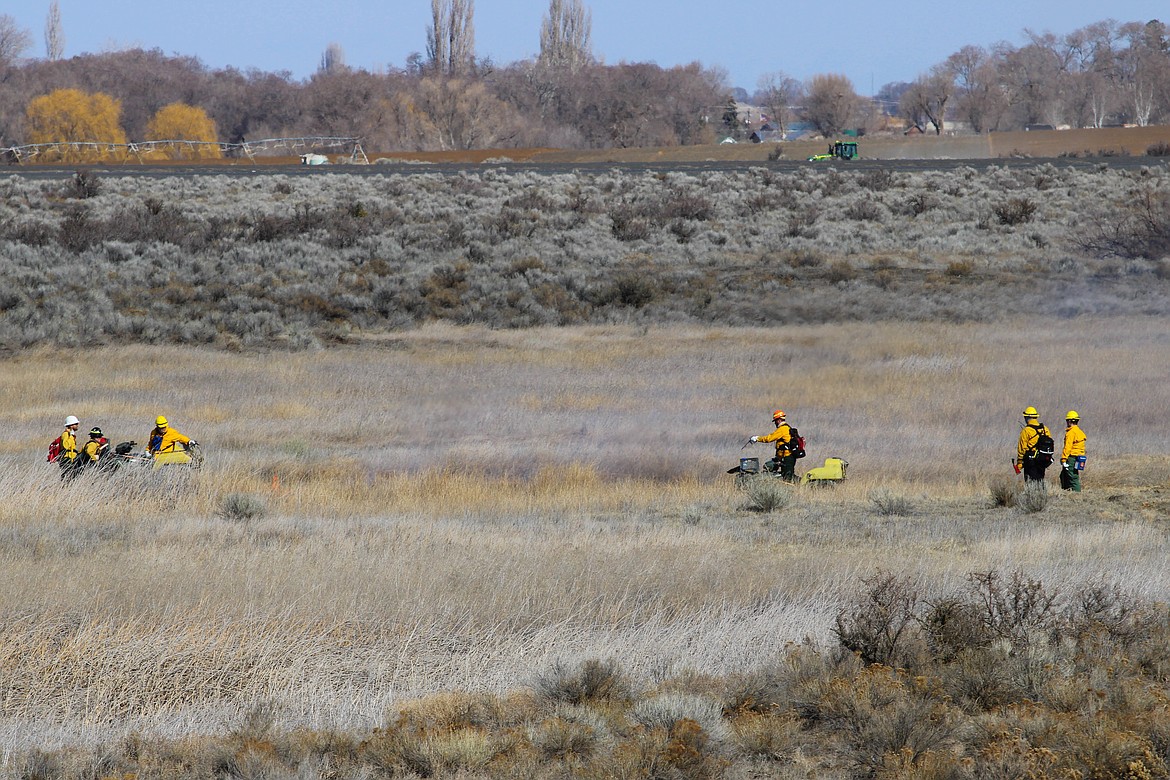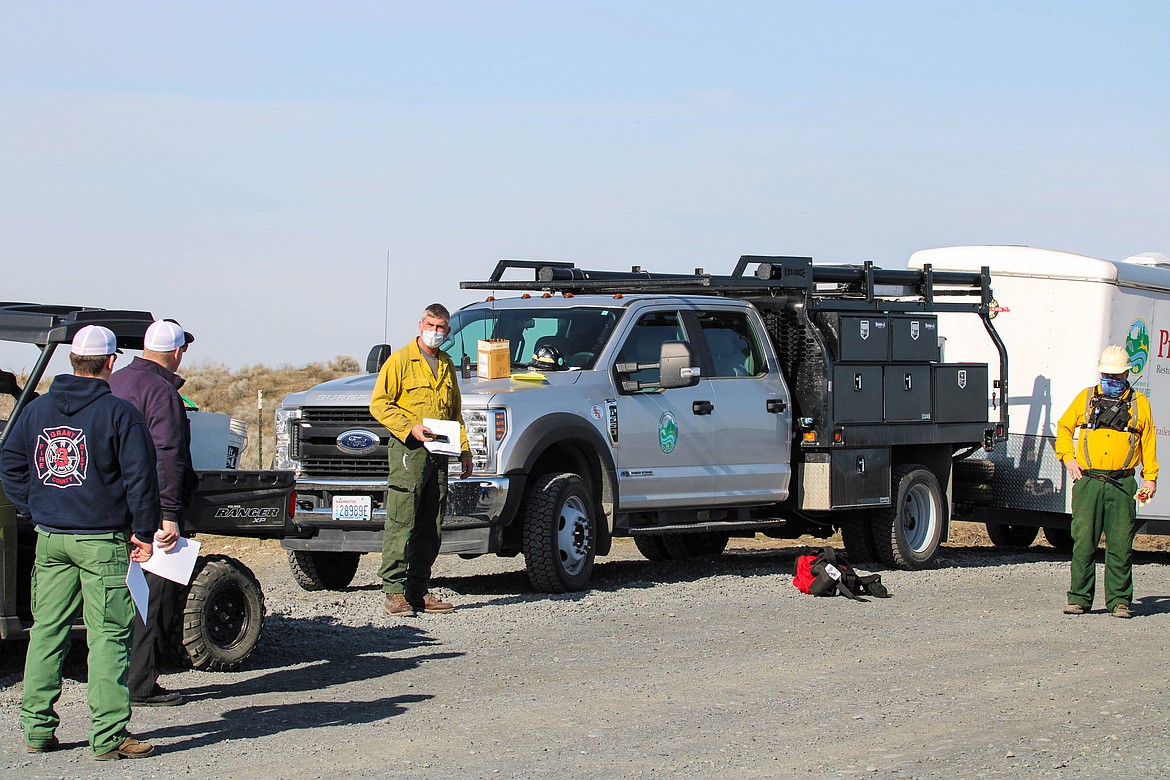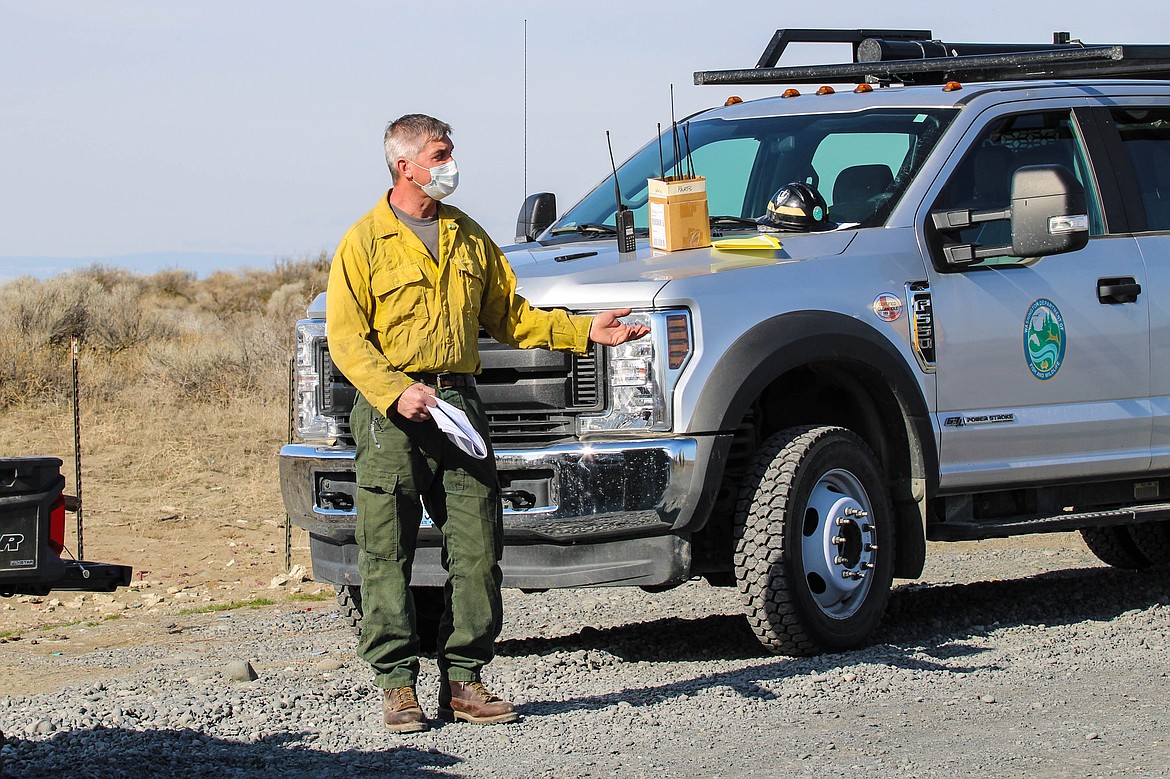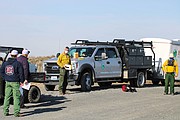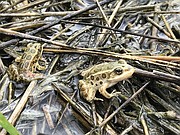Setting fire for frogs: Prescribed burn makes way for endangered amphibian
The Washington Department of Fish and Wildlife’s prescribed burn team met Tuesday morning, west of Moses Lake and south of Interstate 90, to burn 266 acres of tall grass and encroaching vegetation.
The team will be there for as long as it takes to complete the project, said Staci Lehman, WDFW media representative, as the team experienced delays due to unexpected wind.
Three biologists, six yellow-shirted burners and two representatives from Grant County Fire District 3 circled on the gravel offshoot of South Frontage Road East for the procedure and safety protocol.
Prescribed fire manager, or “Burn Boss,” Matt Eberlein split the crew into ignitors, who drop flames along the brush with drip torches, and holders, who follow behind with shovels, rakes and water trucks to control the spread.
The team started with a small test fire before they let loose.
“No matter what field type you burn in, you never really know what it’s going to do,” Eberlein said.
At the day’s end, crew members monitored the burn for safety before retiring for the night, Eberlein said. They set up a 25-foot thick wet perimeter around the burn area, then returned the next morning.
“Prescribed fire, that’s where all the cool people hang out,” Eberlein said.
This is the first time the area’s been burned in nearly 20 years, said WDFW biologist Sean Dougherty. Typically, when a wetland gets this encroached with vegetation, there is a scouring event like a river that forms pockets of habitat. Out near the Potholes Reservoir, that hasn’t happened.
A lot of the land is formed by man-made water systems for irrigation, Dougherty said, so it takes a man-made scouring event to maintain it. The goal is to make the area more of a mudflat. Then the vegetation will reinvade, starting the cycle anew.
While the project’s funding pitch was geared toward the endangered northern leopard frog, with the last Washington population just northeast of the burn area, the burn will benefit a whole host of other wetland obligate species, Dougherty said, such as geese, ducks, killdeer, black-necked stilts and others.
The prescribed burn will help prevent wildfires, which burn hotter and faster, and it will also clear up vital breeding territory for the frogs, which prefer open wetland, Lehman said.
The project is nearly two years in the making, said Dougherty.
Partnering with Idaho Fish and Game, the British Columbia Ministry of Forests, Lands, Natural Resource Operations and Rural Development, Washington State University, the Oregon Zoo and others, the WDFW acquired the Competitive Wildlife Action Grant by the U.S. Fish and Wildlife Service. They also went through the State Environmental Protection Act process, land assessment process and obtained an air quality permit from the Department of Ecology.
“There’s a lot that goes into it,” Lehman said. “They don’t just show up and set stuff on fire.”
Pushing back the start date due to less than opportune weather, the burn came down to now or never, Lehman said. In a week or so of continuing warmth, the northern leopard frogs will come out from hibernating beneath mud and they’d lose their chance.
Northern leopard frogs, which used to be abundant across the state, landed themselves on the endangered list in 1999. A recent survey found 200 breeding females, determined through genetic assessment, in the only population remaining, south of Potholes Reservoir, said WDFW northern leopard frog biologist Emily Grabowsky.
Their decline is attributed to habitat loss, diseases, such as amphibian chytrid fungus, and invasive predators, Grabowsky said. The worst of all is the bullfrog, which invaded from the east coast, and feasts on the northern leopard frog.
While the origin of bullfrogs in this region is unknown, it’s likely they were brought intentionally for fishing bait and pet trade, Dougherty said.
They lay 1,000 eggs at a time and are much hardier than the leopard frog, Grabowsky said, surviving even way up north in environments much harsher than where they came from.
“Something might seem really innocent, like throw in a couple bullfrogs in a pond, and before you know it, five years down the line, they could completely destroy that habitat,” she said.
Not only do bullfrogs eat northern leopard frogs, but pretty much anything they can fit in their mouth, Dougherty said, thus declining the overall wetland health.
“People don’t care about leopard frogs, right? Because ‘I can’t eat ’em, I can’t kill ’em, why do I care?’ Well, bullfrogs have a bigger impact across the board,” he said. “If you like fishing, fish, bass, whatever will eat a bullfrog and a leopard frog equally, but bullfrogs eat everything else.”
Bullfrogs will consume every bug, which ducklings or pheasant and quail chicks need to survive, Dougherty said. Then, they will eat the ducklings and pheasant and quail chicks.
Nothing seems to faze a bullfrog, he said, so the department works toward measures to boost the northern leopard frog, which doesn’t take nearly as big of a toll on the environment.
“Come out here during the summer, July, and find some stagnant little puddle of water and just watch it boil with bullfrogs,” he said.
The WDFW has been monitoring northern leopard frogs in the area for 20 years, Grabowsky said. They do their genetic assessments in the late summer when the frogs are most active. This will determine if the burn was a success.
The March burn is less an experiment and more of a proof of concept, Dougherty said. The department is dialing in their methodology to use it to manage wetlands.
Depending on the late summer findings, Dougherty said, prescribed burns for such causes could become much more prevalent in years to come.




